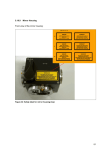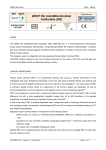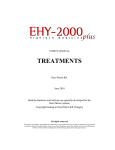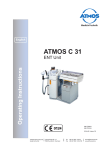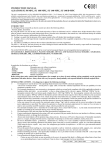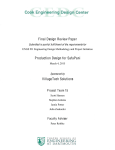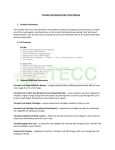Download PrinciPlEs of ElEcTrosurgEry
Transcript
Energy Training Manual Principles of Electrosurgery (Basic) Energy Training Manual: Principles of Electrosurger y (Basic) 3 ContentS 1 Introduction............................................5 4.2 Cutting modes.................................................23 4.2.1 External parameters determining 2 Basics.........................................................7 the cutting results............................................25 2.1 Historical background........................................7 4.3 Output control technologies.............................26 2.2 Principles of electricity........................................7 2.3 Effects of current on tissue..............................13 5 Safety and hazards. ......................29 5.1 3 Principles of electrosurgery....................................15 Safety..............................................................29 5.1.1 HF unit.............................................................29 5.1.2 Power setting..................................................29 3.1 Coagulation.....................................................15 5.1.3 Active electrodes.............................................29 3.2 Vaporization (Cutting).......................................16 5.1.4 Neutral electrodes............................................30 3.3 Carbonization..................................................17 5.2 3.4 Electrosurgical modalities................................17 5.2.1 Smoke.............................................................32 Hazards...........................................................32 5.2.2 Laparoscopic considerations...........................32 4 Electrosurgical modes and technologies.............................21 4.1 Coagulation modes.........................................21 5.2.3 Unintended current flow...................................33 6 Further reading. ...............................35 Disclaimer This document is intended for training purposes on the European and Asian market only. All pages are marked “confidential” which means that it is prohibited to pass this information on to any external party. The comparison to competition has been written to the best of our knowledge at the date of publication. Even if the names of the competitive products mentioned in this manual show no indication of a registered trademark, their trade names are not in the public domain. Please keep in mind that our competitors enhance their products as well, so their products might have changed in the mean time. Make sure you use competitor comparisons only carefully in your conversations with customers. This training material does not constitute medical or legal advice and should not be relied upon as such. This document should not be considered as a substitute for carefully reading all applicable labelling, including the Instructions for Use (IFU) supplied with the devices and published, peer-reviewed articles concerning the topics presented. Before using or selling any product, please thoroughly review the relevant user manual(s) for instructions, warnings and cautions. Energy Training Manual: Principles of Electrosurger y (Basic) Introduction Introduction Electrosurgical units (ESU)1 were first introduced during the early twentieth century and have become an increasingly important component of most of today’s surgical and also endoscopic procedures where cutting of tissue or haemostasis is required. The physician has a wide portfolio of electrosurgical equipment to choose from and more and more sophisticated technologies contribute to more safety for users and patients. Nevertheless, an understanding of the basic principles of electrosurgery is essential in order to achieve the best possible clinical result for each individual case. This guide aims to give the medical personnel a better understanding for the principles of electrosurgery. 1 Our general term nowadays for a generator or ESU is “HF unit”. You will find that term in the following. 5 1 Energy Training Manual: Principles of Electrosurger y (Basic) Basics Basics 2.1 Historical background 7 2 patented the first electrosurgical device – a high frequency spark-gap generator – in 1907. Harvey Cushing and William Bovie collaborated in the 1920s, resulting in an update of these spark-gap generators with sophisticated There have been many reports of using hot oils and technology to increase the safety of electrosurgery. hot irons as crude methods of haemostasis, often with Advances in radiofrequency and computer technology devastating results. Egyptian pioneers recognized as early have continued to increase the safety of these devices and as 3000 B.C. that a bleeding can be stopped by applying enabled the development of versatile bipolar devices. heat. The history of the development of radiofrequency surgery even reaches back to Hippocrates, a Greek physician of antiquity, who used a red-hot iron to arrest the Electrocautery is defined as the use of direct flow of blood (haemostasis) during amputations around electric current to heat an instrument that is used to 400 BC. In the middle of the 19th century, the so-called coagulate and seal tissue. It should not be confused ‘Paquelin burner’ was developed as a thermocauter with electrosurgery which uses alternating current at (instrument for thermocautery) and the so-called ‘galvanic radiofrequency levels to directly heat the tissue instead. cauter’ as an electrocauter: The first of these consisted of a metal pin heated to over 1000 °C by a fuel/air mixture and used for the destruction of tumourous tissue. The electrocauter, on the other hand, made it possible to separate or slough off biological tissue by means of a knife or platinum sling raised to red heat by direct current. 2.2 Principles of electricity Prior to the introduction of high frequency technology at the beginning of the 20th century, such ‘cauterization’ For a better understanding of electrosurgical effects on was the method usually applied in the field of surgery. biological tissue, this chapter will provide an overview on In 1891, the French physicist and biologist d’Arsonval elementary aspects of electricity. reported on thermal effects induced in biological tissue by using alternating current at high frequencies without Electricity is based on electrons, protons and neutrons, the stimulation of muscles or nerves (so-called ‘Faradic which together create atoms. Atoms which have the same effect’). In the year 1908, Nernst could verify that nerve number of protons as electrons are neutrally charged (see and muscle stimulation decreases with increasing fig. 1a). Atoms with more protons than electrons have a frequency. Gildemeister stated in 1912 that above 200 kHz positive charge and are called positive ions. Atoms with stimulation ceases to exist. In the years 1911 and 1912, more electrons than protons have a negative charge and Czerny, Werner and Caan published detailed descriptions are called negative ions (see fig. 1b). of methods for the application of RF current to cut and coagulate tissue that are still used today. Between 1907 and 1910, ‘deep coagulation’ with RF current was developed as a method for tissue destruction, particularly against cancer, by Doyen, Czerny and Nagelschmidt. Doyen even used bipolar applicators. Lee DeForest >> 8 Energy Training Manual: Principles of Electrosurger y (Basic) Basics Electric current When charged particles (electrons, ions) flow through a conductor (e. g. metal, air gaps, tissue) an electric current (in formula referred to as: I) is formed. In other words: Electric current is the rate at which electrons or ions flow along a conductive pathway and is measured in Ampère [A]. The value describes the number of electric charges (electrons or ions) per time (1 A = 6.24 · 1018 electrons per second). Examples: Electronics/ integrated circuits: 1 nA–10 mA (0.000000001–0.01 A) Electrosurgery: 10 mA–10 A (0.01–10 A) Fig. 1a: Structure of an atom Power transmission: 100 A–100 kA (100–100,000 A) Lightning: 200 kA (200,000 A) Note: Current through metal is a flow of electrons. Current through liquids is a flow of ions. Biological tissue consists of a greater or lesser extent of electrolytic liquid (ions) and can conduct electrical current. The effects of electric current on biological tissue are described in chapter 1.3. There are two types of electric current: • Direct Current (DC), where the electricity flows in one direction only (see fig. 2a). Batteries for example supply direct current. • Alternating Current (AC), where the flow direction of the electrons (or polarity) changes continuously Fig. 1b: Positive and negative ions (see fig. 2b). A wall socket supplies alternating current. Alternating current flows in cycles and is bidirectional. The usual waveform of AC is a sine wave. For electrosurgery, only alternating current is used (see chapter 1.3). Fig. 2a: Direct current (DC) Fig. 2b: Alternating current (AC) Energy Training Manual: Principles of Electrosurger y (Basic) Basics Voltage 9 defined to explain all known natural phenomena. The energy is measured in Joule [J]. Energy can be The Voltage (in formula referred to as: U) is the force which converted from one type to the other (e. g. chemical energy is needed to push the electrons or ions through an electric such as coal can be transformed into electrical energy conductor such as tissue and is measured in Volts [V]. One by a power plant; tissue can be heated by electrosurgical volt moves 1 ampere of current through 1 ohm of resistance energy): (see below). A voltage between two poles is generated by the separation of positive and negative charges. The electrical energy can be calculated by multiplying power by time: Examples: E=P∙t Electronics/ integrated circuits: 0.1 µV–10 mV (0.0000001–0.01 V) Electrosurgery: 10 V–7 kV (10–7,000 V) Power transmission: 230 V–400 kV (230–400,000 V) Lightning: Impedance / Resistance several MV (several million V) Impedance (in formula referred to as: Z) and resistance (in Power formula referred to as: R) both represent oppositions to the flow of current, but they are not the same. The energy converted per second by a current which flows through a resistance is called power (in formula referred to Impedance (Z) is the sum of two quantities called as: P) and is measured in Watts [W]. resistance (R) and reactance (X): Power is a product of voltage and current: Z=R+X P=U∙I The resistance (resistive part / real part) of impedance can Power dissipated by resistance produces heat. dissipate power and hence produce heat. The resistance for electrons as they attempt to move through tissue is Note: The higher the power level, the more heat is created measured in Ohm [Ω]. Not all kinds of materials convert in the tissue. electrical energy into heat the same way. Conductors have a low impedance to the flow of electrons and include for Energy example copper, saline, blood and muscle. This is why the neutral electrode (or patient plate, return electrode Energy (in formula referred to as: E, Q) is a physical etc.) should be placed over a large muscle mass during quantity and a property of objects and systems which monopolar electrosurgical applications. Insulators have is conserved by nature. Energy is often defined as a high resistance to the flow of electrons and include air, the “capacity to do work”. Several different forms of rubber, plastic, fat, water and glycine. energy, such as kinetic (movement), thermal (heat), electromagnetic, chemical and nuclear energy have been >> 10 Energy Training Manual: Principles of Electrosurger y (Basic) Basics Reactance is determined by the inductive and capacitive between 300 kHz (= 300,000 cycles/sec) and 4 MHz behavior of the electrical set-up such as condition and (= 4,000,000 cycles/sec) and they are called High position of cables. Frequency (HF) units. Note: The higher the water content of biological tissue, the In the Anglo-Saxon world, high frequency (HF) is often lower is its resistance. called radiofrequency (RF) because radio transmitters also operate in this frequency range. Frequency The frequency (f) can be calculated according to the formula: Frequency is the number of times an alternating current f= 1 T reverses (from minus to plus) in one second and is measured in Hertz [Hz] (see fig. 3). In Europe frequencies with 50 Hz and in the USA 60 Hz are used in household power supplies and may cause cardiac defibrillation due to Example: What is the frequency when one period T takes electric shock. To give an example: Batteries are powered 10 ms? by direct current supply only, that means that the polarity f= does not change at all and the frequency is 0. 1 = 100 Hz 0,01s Low frequency is defined as less than 100,000 cycles (= 100 kHz) in one second. The physical effects of low Circuit frequency electricity can vary and may include pain, muscle and nerve stimulations and even cardiac arrest. All electrical current has to complete a circuit. The current As the human body is less sensitive to current with high is extracted from ground at the power plant and distributed frequencies, electrosurgical generators use frequencies to outlets. The current is then delivered to the patient at the Fig. 3: Frequency of alternating current Fig. 4: Circuit of electricity Energy Training Manual: Principles of Electrosurger y (Basic) Basics 11 surgical site and then returns to the HF unit and back to ground and power plant (see fig. 4). Ohm’s Law In order to perform electrosurgery, a voltage (U) source is applied across the tissue, which causes an electric current (I) to flow. The voltage source and tissue form a simple electrical circuit, with the tissue acting as a resistor (R). The formula simply demonstrates that the resistance of the tissue determines the current flow: I= U R or R= U I or U=RxI Fig. 5: Low vs. high current density This relationship is known as Ohm’s Law. It is one of Current Density the most fundamental laws in the field of electronic and electric engineering and demonstrates the relation Current density (in formula referred to as: j) is the between voltage, current and resistance. concentration of electrical current in the cross section of a conductor and is measured in A /m2. The current density depends on the size and shape of the electrode. Joule’s Law The active electrode of the EndoTherapy instrument has a Current flowing through a resistor causes the conversion very small surface compared to the neutral electrode (see of electrical energy into heat (Q). The converted energy chapter 2.4) with a large surface. A small area results in is measured in Joule (J). In electrosurgery, this heat is high current densities and produces the tissue effect at the generated in the tissue itself. In other words, the resistance surgical site. Bigger areas such as the neutral electrode of the tissue converts the electrical energy of the voltage correspond with a low current density. Figure 5 gives an source into heat (thermal energy) which causes the example for high and low current density respectively. temperature (T) of the tissue to rise. Joule’s law: generated heat = converted electrical energy Q=E j= I A A = cross-sectional area >> 12 Energy Training Manual: Principles of Electrosurger y (Basic) Basics The following table summarizes the most important parameters in electrosurgery: Parameter (Symbol) Unit (Symbol) Equitation Explanation Voltage (U) Volt [V] A voltage between two poles is generated by the separation of pos. and neg. charges. Current (I) Ampère [A] number of electric charges (electrons or ions) per time 1 A = 6.24 x 1018 electrons per sec. Resistance (R) Ohm [Ω] I= U R (Ohm’s law) Resistance is the opposition to the flow of current. Power (P) Watt [W] P=UxI in electrosurgery: product of voltage and current Energy (E, Q) Joule [J] E=Pxt in electrosurgery: product of power and time Heat (Q) Joule [J] Q=E (Joule’s law) Heat is thermal energy. f= 1 T number of oscillations per second j= I R concentration of electrical current in the cross section of a conductor; A = cross-sectional area Frequency (f) Current density (j) Impedance (Z) Temperature (T) Hertz [Hz] [A/m²] Ohm [Ω] Z=R+X º Kelvin [ºK] º Celsius [ºC] º Fahrenheit [ºF] Important rules of electricity 1. Electrical current seeks ground. 2. Electrical current needs a complete circuit to flow. 3. E lectrical current is “lazy” and prefers the path of least resistance. oppositions to the flow of current; x = reactance Energy Training Manual: Principles of Electrosurger y (Basic) Basics 2.3 Effects of current on tissue Depending on the characteristics of electrical current, three different effects can occur: Electrolytic effect Direct current (DC) generates in addition to the desired thermal effect also an undesirable electrolytic effect due to spatial separation of positive and negative ions (see fig.7), producing acids and bases at the electrode poles and resulting in corrosive/acid burns. Therefore direct current is Fig. 6: Three tissue effects caused by current flow. The desired tissue effect is the thermal effect. not suitable for electrosurgical procedures. Faradic effect Alternating current with low frequencies, which are normally used in every household (50–60 Hz), is not suitable for electrosurgical procedures because in addition to the desired thermal effect, these frequencies can produce undesirable physical effects such as pain, muscle and nerve stimulations and even cardiac arrest. The stimulation of muscles and nerves is also called faradic Fig.7: Spatial separation of positive and negative ions causes corrosive/ acid burns. effect or neuromuscular stimulation (NMS). As the human body is less sensitive to current with high frequencies, electrosurgical HF units usually use frequencies above 300,000 cycles/sec (= 300 kHz). Figure 8 shows the current strengths that are necessary to cause neuromuscular stimulation in dependence on frequency. >> Fig. 8: Relationship of current, frequency and neuromuscular stimulation 13 14 Energy Training Manual: Principles of Electrosurger y (Basic) Basics Example: A low current level can already cause a faradic the desired effect but it is the heat generation within the effect at the household frequency of 50–60 Hz. tissue caused by the current flow that results in the cutting The amount of current (I) that is necessary to cause a or coagulation effect. Every tissue type corresponds with faradic effect increases with increasing frequency (f) when a certain resistance which is higher than metal. The tissue starting at 100 Hz. resistance is mainly determined by the water content of the cells. In fat tissue the water content is very low. Fat itself Note: In some cases all HF units can cause neuromuscular cannot conduct electrical current very well since it contains stimulations even at high frequencies due to high current little electrolytic liquid needed for conduction. densities applied. The resistance of fat is approximately 10 times higher than Thermal effect that of blood (see table below). The electrolytic and the faradic effect can be significantly Specific resistance of biological tissue (unit: Ω/cm): reduced by using alternating current with high frequencies Muscle 160–250 of above approximately 100–200 kHz. Blood 160–300 Liver 200–380 The ions move very rapidly, but only short distances and Brain 670–700 therefore do not move across cell barriers. Therefore, Fat 1,600–3,300 there is almost no stimulation and no acid or corrosive Skin 11,000 burns (see fig. 9). The basic principle of electrosurgery is that heat is generated within the tissue when the current Specific resistance of metal (unit: Ω/cm): is flowing through the tissue resistance. In other words, it Copper 0.0000017 is not the metal electrode that heats up and determines Silver Fig. 9: No separation of positive and negative ions and therefore no electrolytic effect Fig. 10: Summary of the effects of current to the tissue 0.0000016 Energy Training Manual: Principles of Electrosurger y (Basic) Principles of Electrosurger y Principles of electrosurgery 15 3 Electrosurgery is defined as the application of HF-current The following chapters describe the three main effects to modify or destroy tissue cells or to dissect or remove caused by electrosurgery: tissue in combination with mechanical surgical techniques. • coagulation • vaporization (cutting) How does radiofrequency current affect tissue? • carbonization Electrosurgery uses radiofrequency current to cut tissue and seal bleeding vessels by producing heat. The heat produced either vaporizes the intracellular fluid and denatures proteins or explodes the cell membrane at the site of the active electrode. The effect of the radiofrequency current on tissue also depends on the current density in a particular area. The effectiveness varies based upon four tissue characteristics: • thickness • vascularity • fat content • liquid content In any type of electrosurgery, eschar formation and buildup may decrease the tissue effect due to poor heat diffusion. Fig. 11: Mechanism of the coagulation effect on a cell 3.1 Coagulation Temperatures of 60–70 °C in the area around the active electrode heat the cells gradually up until their intracellular fluid can escape through holes in the cellular membrane (which are a result of protein denaturation) and thereby result in the shrinkage of the cell (see fig. 11). Thus the haemostatic effect is attained by the denaturation of proteins that leads to the shrinkage of the vessels’ diameter and the clotting of blood. This efficient form of haemostasis is commonly used to stop bleedings in both open and endoscopic surgery and represents an effective alternative to clipping or forms of ligations for smaller vessels. >> 16 Energy Training Manual: Principles of Electrosurger y (Basic) Principles of Electrosurger y 3.2 Vaporization (Cutting) When the voltage between the cutting electrode and the tissue to be cut is sufficiently high (approx. 200 Vp), sparks (electric arcs) are generated between the cutting electrode and the tissue. These sparks are essential to perform the Fig. 12: Mechanism of the cutting effect on a cell cutting procedure and they effectively concentrate the high frequency electric current onto specific points of the tissue. The very high temperatures produced at those points at which the sparks contact the tissue result in a rapid conversion of the intracellular fluid into vapour. That vapour produces a high pressure within the cell membrane resulting in the explosive burst of the cell (see fig. 12). The repetition of this effect around the electrode finally determines the incision. Note: Electrical current, not surgical instruments make electrosurgical cuts. It is important to distinguish the mechanical cutting from the electrosurgical cutting with HF current where the instrument is not in direct contact to the tissue. The spark can not ignite if the tissue has direct contact to the electrode. There is always a small distance between the Fig. 13a: Illustration of the cutting mechanism by spark generation electrode and the tissue and in between there is a layer of vapor allowing the spark to move along the electrode. One important advantage of electrosurgery is the fact that every cut generates at the same time a certain extent of haemostasis as the produced heat is transported to the neighbouring cells which then coagulate. As the electrode passes through the tissue, sparks are produced wherever the distance between the electrode and the tissue is sufficiently small, producing a cut (see fig. 13a/b). Fig. 13b: Cross section of an electrosurgical cut Energy Training Manual: Principles of Electrosurger y (Basic) Principles of Electrosurger y 17 3.3 Carbonization Carbonization is the result of further heating of dehydrated (desiccated) tissue. The solid contents of the tissue are reduced to carbon. Figure 14 illustrates the relation between the temperatures and the tissue effects. This effect is undesired, because a significant charring Fig. 14: Undesired carbonization effect of the tissue surface corresponds with reduced wound healing. Summary of thermal tissue effects in dependence on temperature: up to approx. 40 °C: no significant cell damage above approx. 40 °C:reversible and irreversible cell damage, depending on the duration of exposure Fig. 15: Mechanism of thermal effect to biological tissue using HF current above approx. 50 °C: irreversible cell damage (start of protein denaturation) above approx. 60–70 °C:coagulation: Smaller bleedings can be stopped. above approx. 100 °C:vaporization (cutting): phase transition from liquid to vapor of the intra- and extracellular fluid: The complete dehydration of tissue is sometimes also called desiccation. above approx. 200 °C:carbonization (latin: carbo = coal): reduced wound healing due to significant charring of the tissue surface >> 18 Energy Training Manual: Principles of Electrosurger y (Basic) Principles of Electrosurger y 3.4 Electrosurgical modalities Let’s take a look at current density in monopolar applications. The active electrode has a small surface. This results in a high current density and high thermal effect. The current flows through the body to the neutral The electrosurgical circuit consists of: electrode where the current is spread over a larger area, • HF unit thereby reducing the current density and allowing the • active electrode electrical current to return to the HF unit without causing • patient/tissue tissue damage at the site of the neutral electrode. The • neutral electrode configuration of the active electrode and the application • cables between HF unit and electrodes technique will determine the actual tissue result (see fig. 17). Basically, there are two types of electrosurgical circuits. The basic differences between monopolar and bipolar technology are the size and location of the return electrode. Monopolar electrosurgery is the most common type. Electric current passes from the small active electrode into the tissue, through the patient and then exits the tissue at a large neutral electrode. The amount of high frequency current which flows out of the HF unit through the active electrode is equivalent to the current flow from the neutral electrode back to the HF unit (see fig. 16). Fig. 16: Monopolar electrosurgery Electrical current travels in circuit and always prefers the way of lowest resistance. The neutral electrode ensures that the current travelling to the tissue returns back to the HF unit without causing damage to tissues outside the surgical side. Fig. 17:The current density at the surgical site around the active electrode is much higher than with the neutral electrode. Energy Training Manual: Principles of Electrosurger y (Basic) Principles of Electrosurger y 19 Bipolar electrosurgery differs from monopolar surgery in that the tissue effect takes place between two electrodes that are part of the same device (see fig. 18). Electric current passes directly from one electrode, through the tissue, and then returns via the opposing electrode and back to the electrosurgical HF unit. Current does not pass large parts of the patient’s body, only through the tissue between both electrodes and therefore no neutral electrode is required (see fig. 19, 20). The bipolar technique is safer than the monopolar Fig. 18: Examples for the current flow of bipolar instruments because: • The current exposition to the patient is limited. • The risk of burns caused by the neutral electrode is non existent. • The risk of leakage currents is reduced (see chapter 4.2.3). Fig. 19: Bipolar circuit; No neutral electrode is required as the return electrode is part of the surgical device. Fig. 20:A common bipolar instrument is a bipolar forceps which is used for the closure of blood vessels. Energy Training Manual: Principles of Electrosurger y (Basic) Electrosurgical Modes and Technologies Electrosurgical modes and technologies 21 4 4.1 Coagulation modes The selection of the optimal coagulation mode is dependent Soft coagulation on several external parameters such as the location and size of the bleeding, the tissue properties and the design of A soft coagulation mode represents a contact coagulation the electrode. While the focus during cutting procedures is which means the electrode needs direct contact to the on reproducible tissue effects by implementing automatic tissue. It is recommended for EndoTherapy instruments regulation measurements, the focus for coagulation modes with a relatively large surface of the electrode such as is to effectively stop the bleeding source with reproducible the Coagrasper by Olympus (please refer to respective coagulation effects. The physician can therefore select from treatment recommendations for more detailed information). different types of coagulation modes in combination with A soft coagulation mode is required for larger and the optimal power level according to the requirements of the deeper tissue coagulation and is available in monopolar individual clinical case. or bipolar technique. A benefit of the soft coagulation is the low sticking of instruments and low risk of carbonization. Suitable electrodes for contact coagulation are e. g. ball electrodes, plate electrodes or the side faces of cutting In order to localize the bleeding source an irrigation pump electrodes. The coagulation electrode should have a such as the Olympus AFU-100 can be very helpful. By bigger surface than a cutting instrument. slowly heating up the tissue, the bleeding can be stopped by shrinkage and clotting. In order to avoid unintended Basically it can be differentiated between contact cutting or carbonization, this mode has a voltage limitation and non-contact coagulation. The most important (Up < 200 V) accordingly adapting to the tissue properties. coagulation modes with their characteristics will be described in the following: >> 2 2 Energy Training Manual: Principles of Electrosurger y (Basic) Electrosurgical Modes and Technologies What impact do different output power limits have to the coagulation is required, it is essential to avoid an early effect on the tissue? dehydration by using lower output power settings (see fig. 21, A higher output power level provides in general more lower). Although the coagulation will take longer, the total energy to the tissue than a lower output level. In figure 21 amount of energy provided to the tissue is higher with lower the area E1 represents the amount of energy applied to power settings than with higher settings after t2 (E3 > E1). the tissue after a certain period of time (t1) with at a higher power level and E2 represents the amount of energy at Forced coagulation a lower power level. E1 is larger than E2 after the same period of time. Compared to a soft coagulation the forced coagulation However, a higher output power level corresponds also is employed when a quick and superficial desiccation of with the risk of an early dehydration of the tissue the tissue is required using electrodes with a relatively surrounding the electrode. Early dehydration means also small surface. Voltages with peak values up to 2 kV create a significant increase in the resistance of the superficial sparks with a high intensity and high thermal effect in order tissue layer with the result that no electric current can to achieve a quick coagulation result. Due to the spark be transported to deeper layers. When deeper tissue ignition the possibility of undesired carbonization remains. Fig. 21: The total amount of applied energy depends on the power level (P) and duration (t) of the application and are illustrated as blue and green squares (E1–E3). Note: An early dehydration results that no further current can be applied to deeper tissue layers. The yellow coagulation margins demonstrate the clinical results in dependence of the power level and the duration of the application. Energy Training Manual: Principles of Electrosurger y (Basic) Electrosurgical Modes and Technologies Spray coagulation Continuous cutting modes This coagulation mode represents a technique of A continuous cutting mode is characterized by a pure 23 contactless coagulation and has long been known sine wave. The peak voltage (Up) of a continuous cut under the name fulguration. The active electrode is held mode determines the spark intensity and the coagulation several millimeters above the surface of the tissue. A very depth achieved during the cut. The spark intensity high voltage (several thousand volts) is required to enable increases proportional to the peak voltage and determines a spark ignition even via air gaps of a few millimeters the thermal effect. The higher the peak voltage Up the and results in the formation of a “spark rain”. This energy higher the spark intensity and the higher the thermal effect creates a superficial, strongly carbonized coagulation zone. (= deeper coagulation margin). By moving the active electrode, large wound areas of tissue E. g. in figure 22 the spark intensity increases from the left structures can be coagulated. The resulting coagulum is to the right side, corresponding with a higher voltage level only very superficial and the carbonized area might break and deeper coagulation. open again and result in postoperative bleeding. Argon Plasma Coagulation >> Another method to coagulate tissue without any contact of the electrode is to apply the HF current to the tissue via an ionized gas. This technique is beneficial for positions where the EndoTherapy instrument is difficult to handle and it is often used for preventively coagulating residual areas of cancerous tissue after resection, for haemostasis or to prevent post-operative bleedings. Other benefits are the possibility to treat larger tissue areas superficially and coagulate areas that are difficult to reach by a ‘side-fire’ coagulation. 4.2 Cutting modes Depending on the HF unit and the procedure, there are different kinds of cutting modes available. The cutting modes can be divided according to the wave form of the HF voltage into continuous, “blend” and intermittent. The clinical result of the cut is also dependant on external factors which will be described at the end of this chapter. Fig. 22: Voltage level and spark intensity increases from left to right: A spark ignites above approx. 200 Vp. 2 4 Energy Training Manual: Principles of Electrosurger y (Basic) Electrosurgical Modes and Technologies ‘Blend’ modes Some HF units offer a so called blend mode. The term blend means that the voltage signals are modulated: The sine wave is not regular compared to a continuous mode. A blend mode can consist of sine waves with different phases and amplitudes or even include a pause without any current flow. The modulation happens within microseconds (μs), e. g. 50 μs are the same as 0.00005 seconds. The crest factor is a value that indicates the coagulation depth of an electrosurgical incision. The higher the crest factor the higher the thermal effect and coagulation depth. The crest factor is defined as peak voltage (Up) divided by rms voltage (Urms). c= Up Urms Fig. 23: The left waveform (1) represents a continuous cut mode. The middle (2) and right waveform (3) are modulated. Urms = root means square value of the voltage. The general intention of modulation is to increase the thermal effect by increasing the crest factor (c). All three signals in figure 23 represent the same “average” voltage (Urms), but differently distributed. In the third example (3) the crest factor is bigger than in example 1 and 2. The pause without any current flow between the packages of sine waves is bigger than in example 2 or 1, but the peak voltage Up is higher. A higher voltage level corresponds with a higher spark intensity, higher thermal effect and deeper coagulation margin. Fig. 24: Example for an intermittent cut (Olympus ESG-100: ‘PulseCut; ‘HPCS’ stands for High Power Cut Support) vascular tissue. For those cases an intermittent cut such as The thermal effect increases with increasing crest factor. the PulseCut (see fig. 24) of the Olympus ESG-100 offers a good compromise of cutting and coagulation by combining Intermittent cutting modes a cut phase (T1) followed by a coagulation phase (T2) within one mode. The intermittent cut offers also the benefit of For some applications an additional haemostasis period an enhanced control over the cutting procedure as the is beneficial, e. g. during polypectomies or dissection of cutting phase is interrupted and not continuously. Cut support technology Energy Training Manual: Principles of Electrosurger y (Basic) Electrosurgical Modes and Technologies 25 Note: The thermal effect decreases with increasing cutting speed. In order to enable an immediate start of the cutting procedure, some HF units offer a cut support – named High Duration (cutting speed) Power Cut Support (HPCS) (see fig. 24) – by applying a very high amount of power until a spark is ignited for a The depth of the coagulation margin depends on the very short time (< 50 ms). This high power peak has the cutting speed (bird’s eye view, see fig. 25). effect of rapidly drying out the tissue around the electrode, thereby enabling an immediate spark ignition. The cutting procedure can start right away by reducing the risk of an undesired thermal damage to the tissue. The risk of a mechanical cut can be minimized at the same time. 4.2.1 External parameters determining the cutting results The thermal effect of the cutting procedure also depends Fig. 25:Three different incision lengths after the same period of time. Electrode design on external parameters which are the duration of electrode contact to the tissue, the design and condition of the With most HF units the thermal effect to the tissue is bigger electrode and the tissue properties (see below). with a larger diameter of the electrode. Larger electrodes correspond with a higher current flow and result therefore In order to deliver a high amount of energy into the tissue, in a higher energy penetration and coagulation depth than time is needed (remember: Energy (E) = Power (P) ∙ time (t)). smaller electrodes (for constant cutting speed). The slower the cutting speed is – or the longer the cutting electrode remains on the tissue – the more electrical energy is transformed into heat per unit of length. When a higher thermal effect is required, the electrode should be moved slowly because more energy can be applied to the tissue which results in a deeper heat penetration and denaturated margin (see example 1 of fig. 25). If the electrode is moved more quickly (see fig. 25, example 2/3) then the same amount of energy is spread over a longer incision length than in example 1. The coagulation depth (denaturated margin) of example 3 is smaller than in the examples 1/2. Fig. 26: The depth of the coagulation margin depends on the design and condition of the electrode. >> 2 6 Energy Training Manual: Principles of Electrosurger y (Basic) Electrosurgical Modes and Technologies Note: The thermal effect increases with increasing surface higher than 200 Vp, the spark intensity and therefore the of the electrode. thermal effect is very high and might result in an undesired carbonization. Tissue properties In order to enable reproducible tissue effects independently The thermal effect is also dependant on the tissue from tissue characteristics, today’s HF units offer automatic properties. For example, fatty tissue has a relatively high output control measurements. These sophisticated resistance compared to muscle tissue that is very vascular. technologies are comparable to cars incorporating a cruise Thus a higher voltage is required for fatty tissue in order control. This cruise control maintains the driving speed to achieve the same effect as for muscle layers. More (analogue: tissue effect) on a constant level (analogue: sophisticated HF units can regulate their output according reproducible) independently from external parameters to the tissue properties (see chapter 3.3). such as incline of the street (analogue: increase of tissue resistance). 4.3 Output control technologies Voltage control Since the 80s, an automatic voltage control has been implemented in order to allow the physician to achieve In order to cut tissue, the voltage has to be high enough improved cutting results. The voltage level is kept constant to ignite a spark between the tissue and the electrode. while the output current varies depending on the tissue A minimum voltage of approximately 200 Vp is needed. resistance. When, for example, the resistance of the tissue increases due to dehydration and the voltage is maintained The spark intensity increases in proportion to the on a constant level, the electrical current also decreases peak voltage. Conventional HF units face the issue that and in total the level of output power is lower than without the tissue results are not reproducible due to fluctuations this feature. of the output peak voltage (Up). These fluctuations happen due to external parameters such as the distinct resistance Power and current control of tissue structures, the design of the electrode, the cutting speed and the internal resistance level of the HF unit. In order to optimize the clinical results and contribute to This can lead to irregular cutting and coagulation results more safety for the user and the patient, Olympus has including carbonized or not sufficiently coagulated areas implemented for its ESG HF unit portfolio – additionally even during one single cutting process. As mentioned to the voltage control – the control of power and current above a minimum of approximately 200 Volt peak (Up) output. By combining the limitations of these three is necessary to start the cutting procedure by spark parameters, Olympus optimizes the control of the power generation. If the output voltage is lower than approx. 200 output (see black line in fig. 27) during electrosurgical Vp cutting is not possible. If the output voltage is much procedures. Spark control Energy Training Manual: Principles of Electrosurger y (Basic) Electrosurgical Modes and Technologies 27 the spark intensity on a constant level. This makes the effect on the tissue reproducible. Each mode has a preset A highly sophisticated and effective way of automatic output spark intensity that is kept constant during the cutting control is the constant monitoring and control of the spark procedure independently from the tissue characteristics and intensity. The Olympus HF units (ESG – line) incorporate a electrode design. Another benefit of the FSM is a lower risk Fast Spark Monitor (FSM) which represents an advanced of carbonization due to the spark control. By combining the technology that constantly monitors and reacts to changes spark control with the voltage, power and current, control of the tissue resistance and keeps the power output as low Olympus effectively contributes to the safety for users and as possible and as much as necessary in order to keep patients. Fig. 27: Example of a voltage, power and current control of a cutting mode Energy Training Manual: Principles of Electrosurger y (Basic) Safety and Hazards Safety and hazards 5.1 Safety There are five areas of concern for safety when using electrosurgical devices. These are the HF unit, the power settings, the cords, the electrodes and the environment. 29 5 • In monopolar electrosurgery check the adequacy of contact between the dispersive return electrode and the patient. • Evaluate the power setting and increase the power in small increments. • Clean the active electrode to remove eschar. If problems persist, consider replacing the accessories 5.1.1 HF unit The HF unit should be checked for any signs of damage. and/or the HF unit. • In bipolar electrosurgery, check the alignment of the electrodes. If there is any question about the integrity of the HF unit, it • If electrosurgery is being used in a liquid environment should be checked by a technician prior to use. HF units such as urologic procedures or hysteroscopy, it is should be plugged directly into a wall outlet and not into important to use the correct kind of solution. Monopolar a portable multiple outlet or extension cord. The power applications require the use of non-conductive fluids such cord should be checked to make sure it is not frayed or as water, sorbitol, glycine or mannitol. Bipolar applications damaged. Any other accessories that are attached to the require the use of conductive fluids such as saline. HF unit should also be checked. The instructions for use will provide specific information on what to check and how frequently. Never put heavy objects or containers on top of a HF unit. Fluids and electricity are a dangerous combination. 5.1.3 Active electrodes Safety measures regarding monopolar and bipolar active electrodes include: 5.1.2 Power setting • Inspect the active electrode for damage before use. The power setting of the electrosurgical unit should be • Plug the active electrode into the appropriate receptacle determined by the physician. There are some devices on the HF unit. Never force a connector into a HF unit. that are pre-programmed and will automatically set to the This is a clue that the instrument is not meant to be default values when a particular instrument is recognized by used with that HF unit. Including the insulation, cord and hand piece functionality. the HF unit. The power settings (if not already automatically • Activate the electrode only when ready to use. set) should be adjusted to the tissue type and the size and • Always place the active electrode into an insulated holster shape of the active electrode. If the surgeon repeatedly when not in use. If the active electrode tip is removable, requests that the power output of the HF unit (e. g. Gyrus be sure it is securely attached to the hand piece. ACMI G400) should be increased, check the following items in both bipolar and monopolar electrosurgery: • If the active electrode should fall off the sterile field and down the side of the OR table, disconnect it immediately to prevent accidental activation or related risks. • Ensure that all cords are connected properly to allow the circuit to be completed. >> 3 0 Energy Training Manual: Principles of Electrosurger y (Basic) Safety and Hazards • Frequently clean the active electrode to prevent eschar Interference with electronic implants build up on the active electrode tip and accessories. • Do not activate the electrode if flammable vapours such as those from disinfection solution are present. • Do not reuse single-use electrodes. Electronic implants (like automatic cardioverter & defibrillator, pacemakers, chochlear implants) are being used more and more frequently. The electrical energy of electrosurgical procedures can interfere with some of Additional safety measures these devices. It is always best to check the IFU of the implant or contact the manufacturer of the implant prior • Do not attempt to connect a bipolar instrument to a to using an electrosurgical device. monopolar HF unit. • As with all electrosurgical instruments, turn off the power when not in use, do not place them on flammable materials such as drapes or gauze. 5.1.4 Neutral electrodes The monopolar electrosurgical HF unit may start alarming after repositioning the patient. Switch the HF unit into the Neutral electrodes have many safety considerations. standby mode and check the following items: Wrong application or malfunction of the neutral electrodes • Are all cables secured? are the main causes for endogenous skin burns (=burns • In monopolar electrosurgery: check that the neutral created within the tissue). electrode has good contact with the skin. • Thoroughly assess the skin integrity before and after the Repositioning when using only bipolar devices is usually procedure. not a problem since there is no neutral electrode used. Fig. 28a: Correct application of the neutral electrode with full contact to the skin Fig. 28b: Wrong application as the neutral electrode has no full skin contact. The small contact point of the neutral electrode causes a high current density and corresponds with the risk for endogenous burns. Energy Training Manual: Principles of Electrosurger y (Basic) Safety and Hazards 31 • Make sure that the neutral electrode is in full contact with the skin (see fig. 28). Overlapping of the electrode must be avoided. • Always select a new and unopened disposable, adhesive neutral electrode, appropriate for the patient’s size and weight. • Never use a neutral electrode that has been left open and never cut it to “custom fit” a patient. • Pad placement is key to avoid burns. There must be adequate tissue blood perfusion to promote electrical conductivity and to dissipate heat. For traditional adhesive pads, the ideal placement is on a clean, dry, large muscle mass. Other sites may increase resistance Fig. 29a:Correct application of the neutral elec-trode to the patient with the long site to the treatment site to current flow, thereby increasing the risk of burns. • Place the neutral electrode with the long side to the treatment side (see fig. 29). Otherwise the current density might increase and enhance the risk for endogenous burns. • Avoid proximity to metal prostheses. Remember that electrical current always follows the way of lowest resistance. Metal implants have a very low resistance and could thereby concentrate the current and increase the risk of endogenous burns (see fig. 30). Do not align the neutral electrode in relation to the treatment site so that the implant is positioned in between. • Remove excessive hair from the neutral electrode site. It Fig. 29b: Wrong applications may be necessary to shave the site for optimum contact. • Place the neutral electrode as close to the surgical site as possible. • Maintain complete contact with the patient’s skin. Gaps in the adhesion of the pad to the patient’s skin could result in a burn as the entrapment of air acts as an insulator. • Plug the neutral electrode into the appropriately labelled receptacle on the HF unit. • Remove all metal jewellery from the patient. • Avoid contact between two neutral electrodes when more than one HF unit is used. • In bipolar electrosurgery, no neutral electrode is needed. >> Fig. 30:Endogenous burns might result if a conductive implant is located between the surgical site and the neutral electrode. 3 2 Energy Training Manual: Principles of Electrosurger y (Basic) Safety and Hazards Recommendations mutagenic or carcinogenic potential. The NiOSH2 released a study in 1998 regarding the effects of smoke on OR Basically, there are two types of neutral electrodes: split or personnel. This included nausea, headache, myalgia, upper non-split ones (see fig. 31 a/b). respiratory infections and eye and skin irritation. In order to minimize the risk of burns, the use of split neutral High filtration pumps for smoke evacuation are electrodes is recommended because most HF units such commercially available to filter the hazardous chemicals as the Olympus ESG line incorporate an additional safety from the plume that is the result of lasers or electrosurgery. feature in combination with split neutral electrodes: The In addition, the use of a high filtration mask is Contact Quality Monitor (CQM) of the ESG-100 constantly recommended to reduce the exposure. monitors the contact quality of the split neutral electrode to the tissue. If the contact quality decreases to a risky level, the HF unit will give an acoustic feedback and disable the activation in order to avoid any burns. 5.2.2 Laparoscopic considerations Laparoscopic surgery requires particular considerations 5.2 Hazards for electrosurgery. Surgery is performed in a moist environment with limited access and visibility. Electrosurgical tools are frequently used due to their 5.2.1 Smoke versatility, reasonable costs and overall ease of use. An The heat produced by an HF unit results in the formation mechanisms of injury can enable the medical personnel to of bioaerosols which are composed of gases and particles facilitate safe tissue dissection and effective haemostasis. matter from patient tissue, both vital and dead. Particles, Bipolar devices are becoming more popular due to safety varying in size from 0.1 to 5.0 µm (microns), may include concerns with monopolar devices. awareness of the hazards and an understanding of the both viruses and bacteria. The noxious gas produced carries many chemicals, some of which may have either 2 National Institute for Occupational Safety and Health Fig. 31a: Split neutral electrode Fig. 31b: Non-split neutral electrode 5.2.3 Unintended current flow Energy Training Manual: Principles of Electrosurger y (Basic) Safety and Hazards 33 acoustic and visual signal if the value of the earth leakage current exceeds a certain level. The signals make the physician aware that there is an increased risk of burns for the patient. High frequency alternating current always corresponds with a certain level of leakage currents. Leakage currents Note: The Olympus HF units will not disable the activation represent current flows which travel another pathway than of the HF unit immediately as the physician might be in the initially intended. In the ideal case. the current that leaves the middle of a life saving procedure. HF unit should travel back via the neutral electrode to the HF unit (see fig. 32, ‘I1’). But a certain percentage of the current Another phenomenon of electricity is that high frequency could alternatively travel via the patient and the operating alternating current can pass from a conductive material (like table (see fig. 32, ‘I2’) or the surgeon (see fig. 32, ‘I3’) and an active electrode) through an insulator (e. g. the insulation then via the ground back to the HF unit. These alternative of the electrode) into another nearby conductive material current flows are also called earth leakage currents and (e. g. biological tissue) without the aid of wires or cables. correspond with the risk of thermal tissue damages. This can occur despite intact insulation surrounding the conductors and is called capacitive coupling. Sophisticated HF units such as the Olympus ESG line constantly monitor earth leakage currents and give an >> Fig. 32: In the ideal case the current that leaves the HF unit (I1) should travel back to the HF unit via the neutral electrode. I2 and I3 represent earth leakage currents. 3 4 Energy Training Manual: Principles of Electrosurger y (Basic) Safety and Hazards Those capacitively coupled currents are often also called leakage or stray currents which occur mainly in monopolar electrosurgery. Due to capacitive coupling, the current can pass from the active electrode via air or insulating material to the metal tube (e. g. trocar) and onto any tissue in contact with the metal tube. Should the metal tube make contact to a small area of the bowel wall, a burn could result (see fig. 33). Direct Coupling is the movement of electrons directly from one conductor to another. This occurs when the surgeon touches the active electrode to a metal instrument or object in the field and accidently activates the HF unit. Fig. 33: Capacitive coupling The first electrode can then activate the other instrument and create an unintentional burn on the tissue it is touching (see fig. 34). In laparoscopic surgery, never activate the electrosurgery unit unless the uninsulated part of the active electrode is in full view. Insulation failures occur in monopolar electrosurgery and describe the breakdown of insulation along the shaft of an active electrode. This failure allows the energy an opportunity to seek another pathway of lesser resistance. In this case the current can either activate another metal instrument or inadvertently directly burn tissue (see fig. 35). Fig. 34: Direct coupling In summary, all electrosurgical devices should be handled with respect. The staff using these devices should be thoroughly trained. If there is no automatic regulation of the output power available, the suitable voltage/power setting should be used to achieve the desired tissue effect. Requests to increase the power setting should trigger the nurse to ensure that all cords are properly connected and the neutral electrode is properly applied. Electrosurgical devices are used daily in the surgical suite and assist the perioperative team to deliver safe and efficient patient care. To ensure patient safety, the principles of electrosurgical safety must be understood and all safety measured observed. Fig. 35: Insulation failure Energy Training Manual: Principles of Electrosurger y (Basic) Further Reading FURTHER Reading • AORN guidance statement: Care of the perioperative Electrosurgery: history, principles, and current and Recommended Practices, and Guidelines, 2005 future uses. Journal of the American college of a review of basic principles. Gastrointestinal Endoscopic, 28:73-6, 1982 • Cotton PB, Williams CB: Colonoscopic Polypectomy. Practical gastrointestinal endoscopy. Blackwell, Victoria, 2008 • Curtis LE: High frequency currents in endoscopy: a review of principles and precautions. Gastrointestinal Endoscopic, 20:9-15, 1973 • Czerny V: Über Operationen mit dem Lichtbogen und Diathermie. Dtsch Med Wochenschr, Vol. 35, No. 11, 489-493, 1910 • D’Arsonval A: Action physiologique des courants alternatifs. C R Soc Biol, Vol. 43: 283–286, 1891 • Doyen E: Traitment local des cancers accessibles par l’action de la chaleur au-dessus de 55 °C. Rev Thér Méd Chir, Vol. 77, 551-577, 1910 • Doyen E: Bipolaire Voltaisation. Münch Med Wochenschr, Vol. 48, 2516 ff, 1908 • Gildemeister M: Über die im tierischen Körper bei elektrischer Durchströmung entstandenen Gegenkräfte. Pflügers Archiv, Vol. 149, 389-400, 1912 • Heymann E: Chirurgische Eingriffe mit Hochfrequenz strömen. Med Klin, Vol. 15, 539-545, 1930 • Huschak G, Steen M, Kaisers UX: Principles and risks of electrosurgery, Anasthesiol Intensivmed Notfallmed Schmerztherapie, Jan 44(1):10-3, 2009 • H.-D. Reidenbach: Hochfrequenztechnik und Laser in der Medizin. Springer-Verlag, Berlin, 1983 • Laine L: Bipolar Multipolar electrocoagulation. Gastrointestinal Endoscopic, 36: 538-41, 1990 • Luciano AA, Soderstrom RM, Martin DC: Essential principles of electrosurgery in operative laparoscopy. J Am Assoc Gynecol Laparosc, May 1(3):189-95, 1994 6 • Massarweh NN, Cosgriff N, Slakey DP: patient with an implanted electronic device. • Barlow DE: Endoscopic applications of electrosurgery: 35 Surgeons, Mar 202(3):520-30, 2006 • Morris ML.: Electrosurgery in the gastroenterology suite: principles, practice, and safety. Gastroenterology Nursing, Mar-Apr 29 (2):126-32, 2006 • Nagelschmidt F: Über Hochfrequenzströme, Fulgu ration und Transthermie. Z Phys Diat Ther, Vol. 3, 1909 • Nernst W: Zur Theorie des elektrischen Reizes. Pflügers Archiv, Vol. 122, 275-315, 1908 • Swerdlow DB, Salvati EP, Rubin RJ, Labow SB: Electrosurgery: Principles and use. Diseases Colon Rectum, Jul-Aug;17 (4):482-6, 1974 • Vilos G: How to Do Electrosurgery Safely. Outpatient Surgery Magazine, July, 2000 www.olympus.com www.olympus-owi.com W7.070.290 1.2_12/09 Printed in Germany




































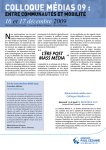


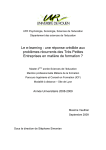
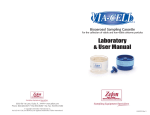
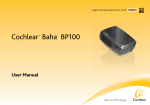
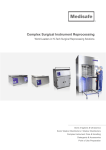

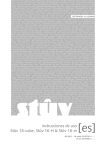

![instrucciones de uso Stûv µM [es]](http://vs1.manualzilla.com/store/data/006183224_1-65be4670b11a3431d0ef47567c38eaf2-150x150.png)


